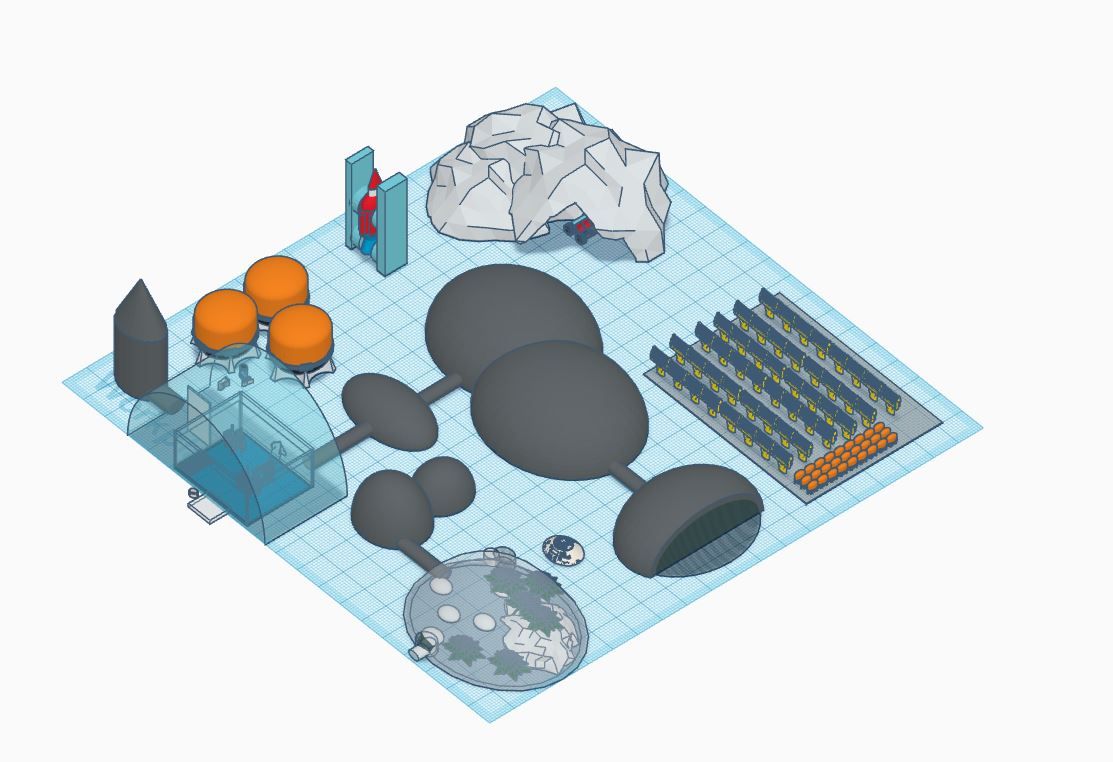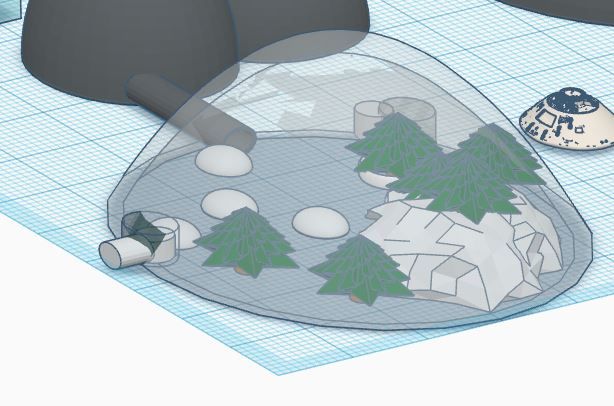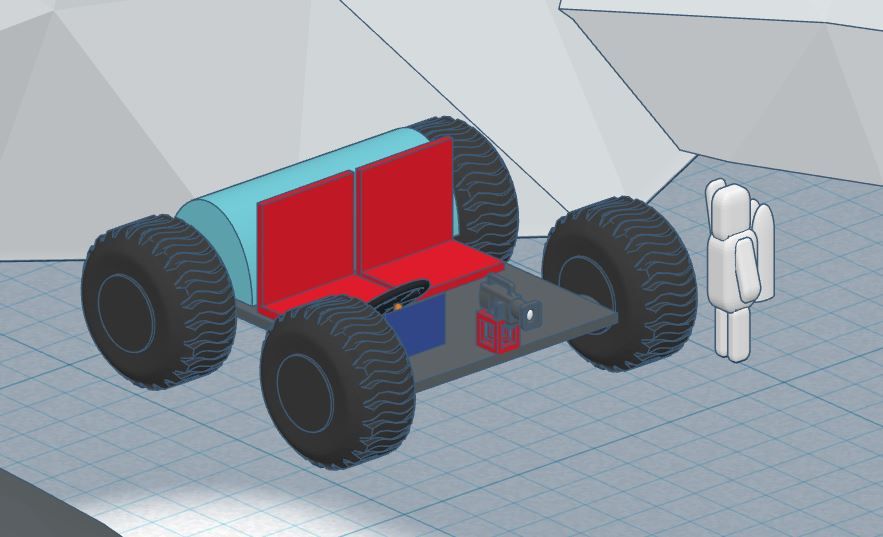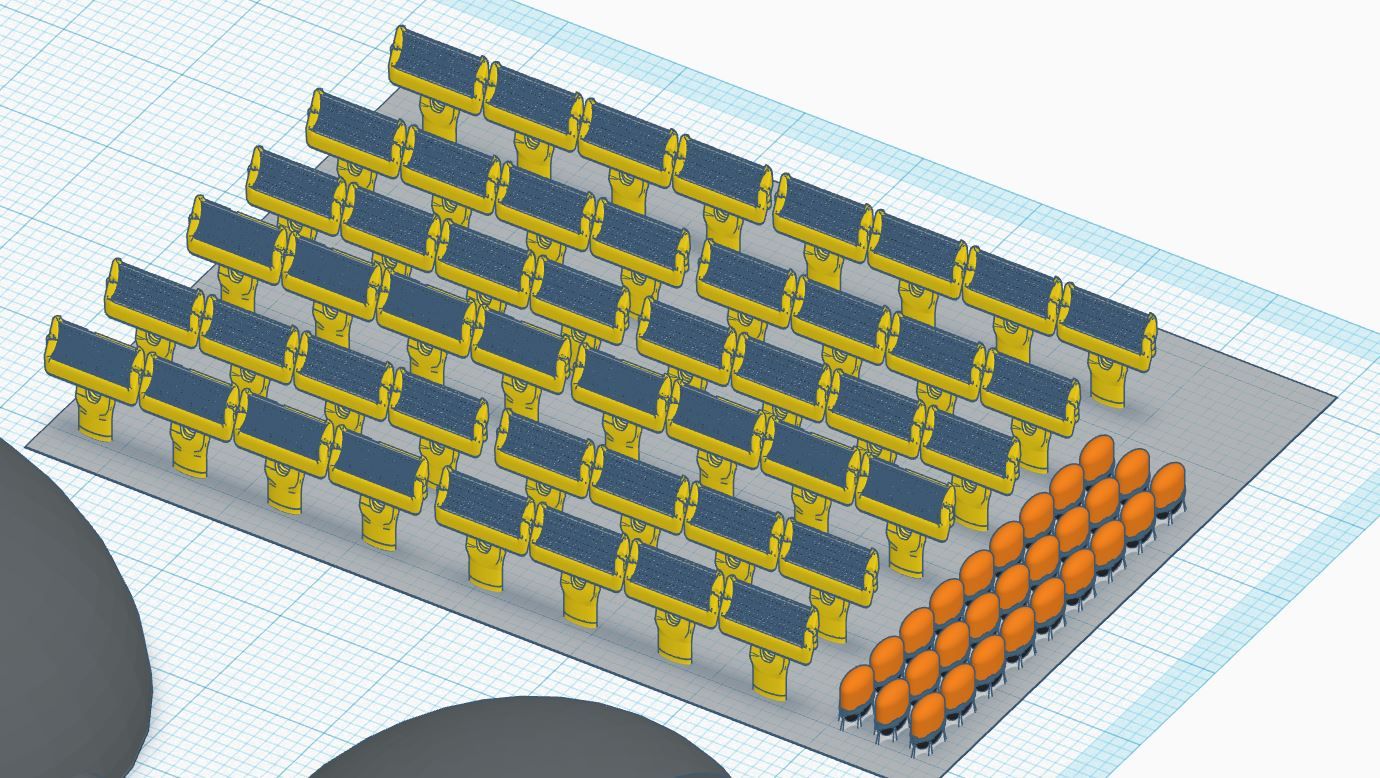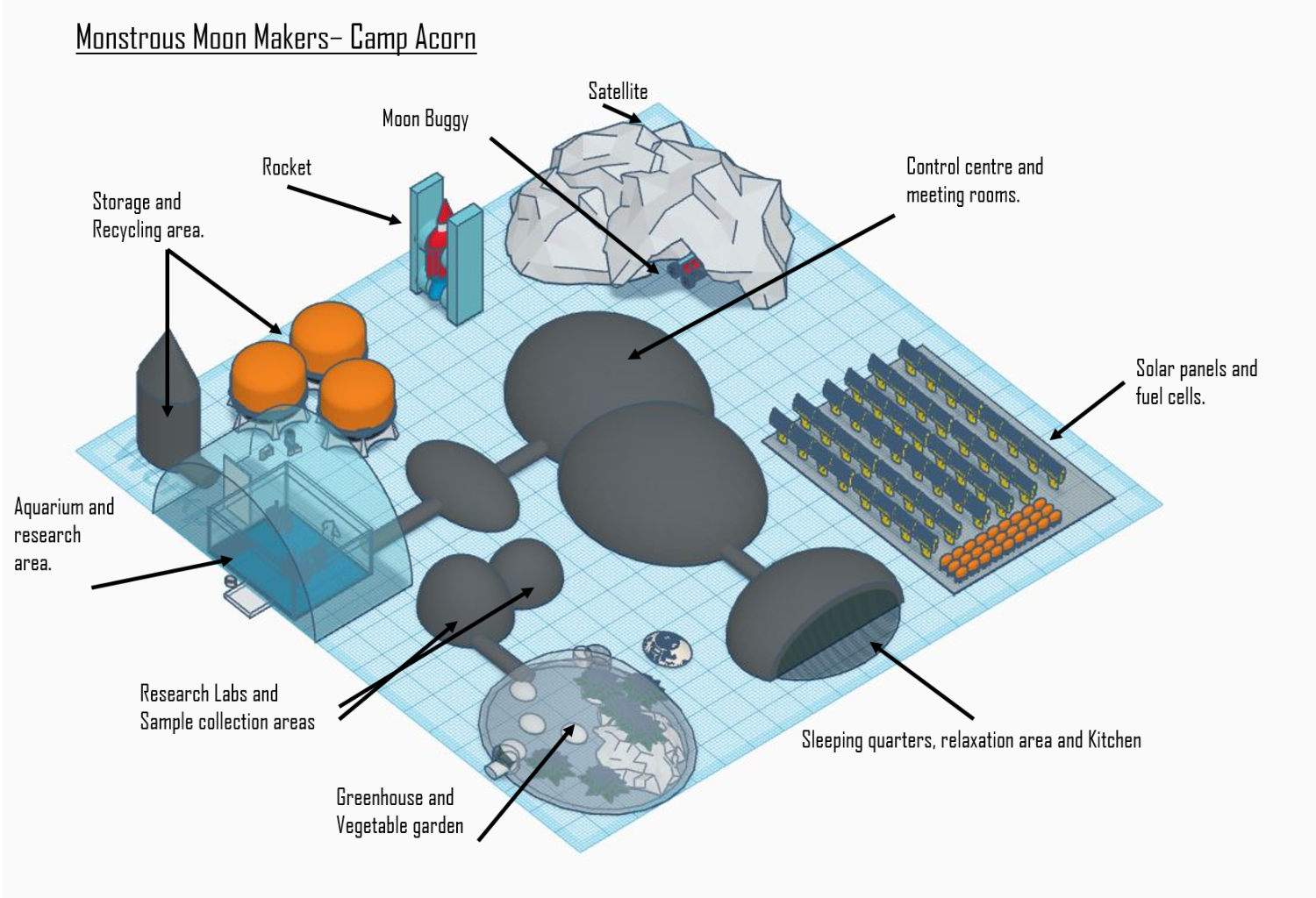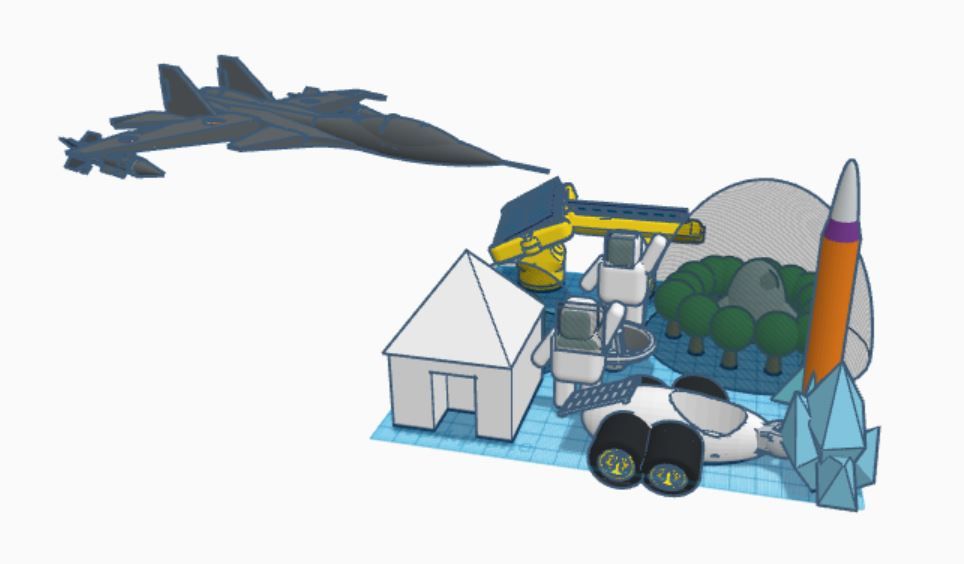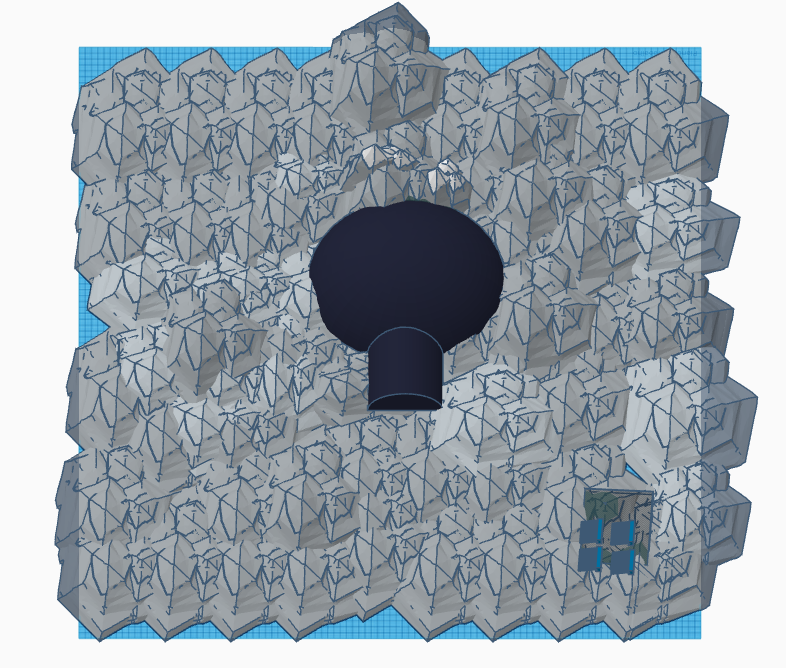Moon Camp Explorers Gallery 2021-2022
In Moon Camp Explorers each team’s mission is to 3D design a complete Moon Camp using Tinkercad. They also have to explain how they will use local resources, protect astronauts from the dangerous of space and describe the living and working facilities.
Team: Monstrous Moon Makers – Camp Acorn
The March C of E Primary School Chichester United Kingdom 10 5 / 2
External link for 3d
|
Project description
Our Moon camp, Camp Acorn, is a base designed to enable research into the protection of human kind on the moon and study how, in the future, we might be able to live safely on the moon. The camp is called Camp Acorn because it provides a safe environment like an acorn shell; and protection from the sun, radiation, meteorites, gasses and the vacuum of space. We also expect it to be the start of a much larger camp in the future and will develop in to an “oak tree”. We are sending two astronauts, one male, one female to spend less money and less supplies. The astronauts we are sending into space have special qualities: the female is a medic and so is the male but he specializes in scientific discoveries and construction. We will make use of potential lunar resources and materials such as volatiles and minerals, we will study these materials and make discoveries about their potential usage on earth. We have UV protection pads for the heat and dangers of the sun. For the vacuum of space we have self making gravity blocks that keep your feet on the ground; also to prevent vacuum we have airlocks. The meteorites will be broken down by protective shields that are made of titanium covered in UV pads. Our camp will just be the start of new adventures and discoveries. It will be across more of the moon in the future. |
||||
|
Where do you want to build your Moon Camp?
Shackleton crater Why did you choose this location?
We chose this location because there a lot of sunlight which means we can have green houses and also be able to mine water from where the lunar poles are, have a flat surface which means you won’t need such a thick floor because of the rocky surface. Sunlight also means we can use solar panels to charge our moon buggy, lights and provide electricity. We will be protected from meteorites as we will be in the crater. There is research to show that the crater has a high mount of hydrogen, this can be used to make water. How do you plan to build your Mooncamp? Which materials will you use?
We are going to make our base from Titanium and Polycarbonate primarily. The titanium is very strong but also it is easy to use. It can withstand very high temperatures and will not rust. All metal work on our camp will be made from Titanium. For our tools and drills we will use tungsten because it is very dense and won’t melt. For the greenhouse and Aquarium we will use Polycarbonate which is clear, hard and easy to work in hot and cold temperatures. We will use rovers and robots to build the foundations to one side of the crater which will mean we will be protected from some radiation and meteorites. |
||||
|
Water
|
Food
|
Electricity
|
Air
|
Protection
|
|
Once we have used up our supplies that we will bring from Earth, we will use a filtration system to purify our urine waste and we will mine lunar ice which we will then convert to drinking water. We will make use of a water recycling system such as the one on the International Space Station. We will need airlocks and deliveries of water from Earth to survive long term on the moon. |
Our first rations of food will be brought from earth in the form of freeze dried and packaged food. Once base has been set up we will have a green house, strawberry garden, fish/ squid to kill from the aquarium and from the greenhouse with apples and carrots. We will grow potatoes, tomatoes, and flowering plants in our green house and investigate the possibility of chickens surviving on the moon to provide us with meat and eggs. Our green house will have black out windows as plants cannot survive in sunlight alone and will need some darkness. |
Building our camp near the lunar poles will mean that we will have almost permanent sun light so we will be able to have a load of solar panels for our power that we can get from the sun. However, in order to be sure we always have the power we need we will have several solar panel locations. We will store the solar power in fuel cells for use during lunar eclipses and emergencies. We will use our lunar rover to move the cells around to the places we need it. |
What we can bring from Earth in tanks, we will. Then for future air we will use lunar soil as the lunar soil is 42% oxygen. We will make robots that can use heat and electricity and be able to extract the oxygen from the soil. We will also get oxygen from the plants in our green house and the algae in our aquarium. We will store the oxygen in tanks for use when needed but will probably need regular deliveries of oxygen from earth. |
We have UV protection pads to protect us from the sun’s rays. As protection from meteorites and from meteorite showers, we will build our base in the Shackleton crater which will provide protection from meteorites. We will use Titanium to build our camps exterior as it is a very strong metal. |
|
Describe a day on the Moon for one of your Moon Camp astronauts
We are going to stick to Earth hours to help our astronauts acclimatise to life on the moon. This is a day in the life of both of our astronauts. They will have time apart but will mainly stay together to promote mental health and wellbeing.
07.30 – wake up/ morning toilet and change into gym clothes 07.45 – morning exercise and stretch (45 mins) 08.30 – wash with bucket of water and then change 08.45 – breakfast (30 mins) 09.15 – ride moon buggy to collect moon rock (to take back to earth) 10.00 – Research and lab time. 11.45 – check the gas tanks and airlock doors circulate camp and check it. 12.30 – rest 13.00- lunch 14.00 – work in the greenhouse (pick some strawberries for dessert) 14.30 – Clean aquarium and study animal development (kill fish from aquarium for dinner) 15.00- run on treadmill 16.00- afternoon toilet 16.15- check everything is working ok 17.00 – prepare for dinner 17.30- eat dinner 18.30 – Update Earth on progress. 19.00- Satellite call home and exercise 20.00 – Check camp and airlocks, water plants and feed fish. 21.00 – relax and read. 21.30 – prepare for bed. 22.00 – evening toilet 22.30- go to sleep |
||||



